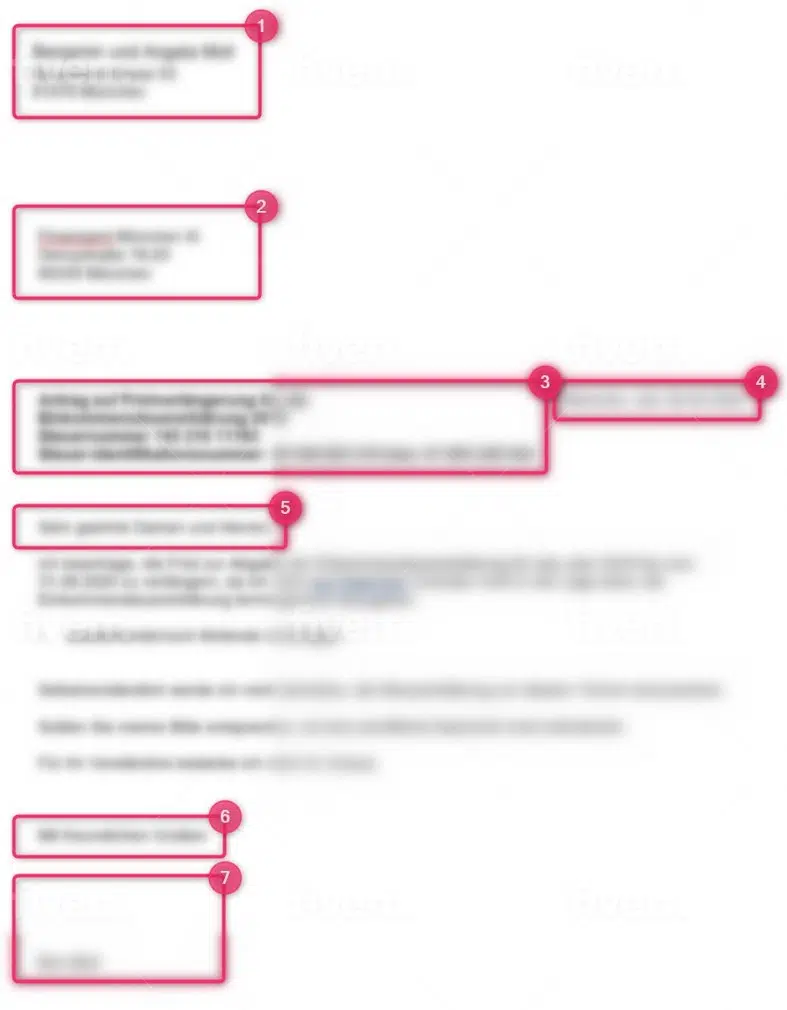Learning how to write a letter in German with this step-by-step guide is as easy as writing an email in German. Before starting with the step-by-step guide based on my day-to-day experience, I want to let you know that Germans use paper in DIN formats.
The most common size for letters that you will find is DIN A 4. The standard size measures 210 x 297 mm based on din-formate.info. Most likely, you won’t have to worry about the correct size because your employer only has DIN A 4 paper loaded into their printers.
Key takeaways
- In this step-by-step guide on how to compose a letter in German, I will cover, on the one hand, some general rules that I learned over the years during my work-related and private communication.
- I cover essential elements like where to put your address and the recipient’s address.
- Regarding the structure of a letter written in German, I cover both scenarios: business-related and personal letters.
- You will also learn where to put the subject and date in a German letter.
- Closing this article, I provide a few examples of formal and informal greetings, salutations, and closing formulas.
How did I learn to write a letter in German?
At least in the business world, emails are Germany’s most commonly used communication method. As you might remember from my article on how to write an email in German, you know that I had to write an email very soon after arriving in Germany. Writing letters happened several months later.
So, the first letter I had to write was for the “Finanzamt” or tax office. They asked me to confirm something. Since, at that time, email wasn’t their preferred medium, I had to write my first letter in German.
General rules on how to write a letter in German
Learning to create a letter is equally crucial because letters are the standard in German. By learning how to write those, you will also have an easier time reading and understanding German letters. You will learn to use common phrases, where vital information should be, and more.
It’s essential to check your spelling and grammar if you don’t feel very familiar with it yet. In the last paragraph of this article, I give you some hints on where you can find help online or in a book. What also helped me a lot was that I could talk to one of my neighbors and ask him to proofread the first letters I wrote.
Here you can find a screenshot of a standard letter template I use.
The “Absender” or sender in a letter in German
As important as the recipient of a letter is the sender. Make sure to include your address above the recipient’s address on top of the letter. You can see the standard position at number 1 in the screenshot above.
The address or “Anschrift” of a letter in German
A letter follows specific rules and forms in German. The “Anschrift” or address should never miss on a letter. If you are writing a letter in Word, an excellent place to put it is on the left. The address should be above all the elements mentioned in the chapter “the structure of a letter in German”.
If it’s a formal letter, the address should include the name of the company, the recipient’s name, the street address and house number, zip code, and city. Of course, sending a letter to a private person won’t require including a company name.
The best position to put the recipient’s address is number 2 in the screenshot.
The subject or “Betreff” in a German letter
If you are writing a letter for business purposes, you should include the “Betreff” or subject before even greeting the recipient. Make sure it’s short, detailed and contains the main reason for your letter. The best position for it is number 3 in the screenshot.
City and Date when you wrote the letter
Following the “Betreff” the “Ort” and “Datum” should be included where the letter is coming from. The best format for that is, for example, “Hamburg, 22.07.2022“. You can find this at number 4 in the screenshot.
The structure of a letter in German
The structure of a letter in German follows similar rules as an email in German. So let me explain more about it based on my work experience.
Writing a letter in German for business
After the subject, city, and date line, you should start with the formal greeting. In the screenshot, the greeting is at number 5.
You can find some examples of formal greetings in one of the later paragraphs in this article. You can then write your letter by following a few standard rules:
- Try to come straight to the point.
- Keep sentences short and straightforward.
- Provide the most critical information in your letter that the reader might require to understand the context.
- Ask them either for a reply until a specific date or for confirmation that they received the letter.
- If no reply is required, you may mention that this letter is to inform them of something.
A formal closure (number 6 in the screenshot) is included after the paragraphs. I recommend leaving a few lines of space, writing down your full name, and using the whitespace between the closure and your name to sign it. Again, you can find some examples a few paragraphs later.
You can see an example at number 7 in the blurred screenshot above.
Writing an informal letter in German
Writing an informal letter requires less attention to detail. I received informal letters, for example, from friends I hadn’t met. Those letters usually do not include any subject but a city and date.
It’s followed by an informal greeting like “Hallo (my name),”. The significant difference between informal letters is the greeting and the writing style. Sentences tend to be longer, and the content does not need to be that objective.
If you want your friend to reply, consider mentioning that in the last sentence of your letter. Use one of the informal closing formulas mentioned below and sign the letter. Since the recipient knows you by your first name, there is no reason to write down your name and leave whitespace for your signature.
Formal and informal greetings and salutations in a letter in the German language
Similar to emails, the formal and informal greetings and salutations in a letter written in German is the same. Here are some examples of it.
Formal greetings and salutations in a letter in the German language
- Sehr geehrte (include her last name) for “Dear Ms. (last name) ”
- Sehr geehrter (include his last name) for “Dear Mr. (last name)”
- Sehr geehrter Herr Doktor (his last name) for „Dear doctor (last name)“
- Sehr geehrte Frau Doktor (her last name) for „Dear doctor (last name)“
- Sehr geehrte Damen und Herren for “Dear Sir or Madam”
- Guten Tag, Herr (include his last name) for “Good day Mr. (last name)”
- Sehr geehrte Kollegen for “Dear colleagues” is only applicable if you say “Sie” to some or most of them
Informal greetings and salutation in a German letter
- Liebe Frau (her last name) for “Dear Ms. (last name)”
- Lieber Herr (his last name) for “Dear Mr. (last name)”
- Lieber (his first name) for “Dear (first name)”
- Liebe (her first name) for “Dear (first name).”
- Hallo (her first name) and (his first name) for “Dear (her first name) and (his first name)”
- Hallo for “Hello”
Closing a letter in German properly – formally and informally
- Mit freundlichen Grüßen – “With kind regards“
- Mit besten Grüßen – “Best regards”
- Beste Grüße – “Best regards”
- Viele Grüße – “Many greetings” (less formal)
- Liebe Grüße – “Kind regard” (casual)
- Bis bald – “See you soon” (informal)
Check the spelling and grammar
To check the spelling and grammar, if you are not yet that familiar with German, I recommend using one of the following websites and books.
The commonly used word processor is Microsoft Word in Germany. To be able to use it properly, make sure that you update your language settings. This will allow you to use internal spell-checking.
First, mark all the text you’ve written, go to the bottom left corner in Word and click on the language. Make sure that the checkbox at “Do not check spelling or grammar” is not activated. Since Microsoft Word recognizes your writing language, German (Germany) should be selected already.
From my experience, The spelling and grammar check is not working 100%. It may happen that it does not recognize sentence structure. But it will detect significant mistakes easily.
In case you prefer to work with books, I can recommend the book: Duden Ratgeber – Briefe, E-Mails und Kurznachrichten gut und richtig schreiben*. I still use an older version of that book regularly if I have doubts about my writing.
There are two additional online tools. The first one is a translation program called DeepL Translator. You can write your letter in one of the many available languages and get it translated automatically into German.
If you want to look up some words or phrases in specific, you can use the online grammar test by the Duden publishing company.
Conclusion
After probably reading the article about how to write an email in German, you can see that writing letters in German are very similar. I hope that I was able to provide you with enough information so that you feel confident in starting to write your first letter in German.
USEFUL INFORMATION ABOUT GERMANY
JOBS IN GERMANY
> How To Get A Job In Germany
___
INSURANCE IN GERMANY
> 15 types of insurance in Germany any expat should have
___
FINANCES IN GERMANY
> Find Best Rates for Loan in Germany
___
WAGES AND TAXES IN GERMANY
> Tax return Germany – Everything you need to know
> Average Salary in Germany Latest Data
___
WORKING IN GERMANY
> CV in German with Europass: How to fill in step by step
___
LEARNING GERMAN LANGUAGE
> How to learn German fast: Top 10 strategies
* The links that are marked in this way are affiliate links and indicate that we receive a small commission if you decide to buy the products or services offered by our partner sites. But for you, it won’t cost anything extra.



